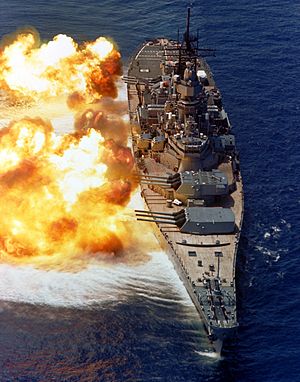Battleship facts for kids
A battleship was a very big, strong warship. It had thick armor and huge guns. These ships were much larger and tougher than other warships like cruisers or destroyers. For many years, battleships were the most important ships in a navy. They showed how powerful a country's navy was. Their main job was to control the seas.
Contents
How Battleships Changed Over Time
Early Armored Ships
Long ago, warships were made of wood. But then, new shells were invented that could explode. These shells could easily destroy wooden ships. So, navies needed ships with strong armor.
In 1859, France built a ship called Gloire. It was the first large warship with iron armor. Gloire was mostly made of wood, but it had a thick layer of iron on its sides. It also had a propeller, even though it mostly used sails. This new ship made other countries, like the Royal Navy of Britain, want to build their own armored ships. Smaller armored ships were also used by the United States Navy during the American Civil War for river battles.
The Age of Dreadnoughts
A huge change happened in 1906. Britain launched a new battleship called HMS Dreadnought. This ship was so advanced that it made all older battleships seem old-fashioned. Dreadnought had many large guns of the same size. It was also powered by steam turbines, making it very fast. After Dreadnought, all new battleships were built in a similar way.
What Battleships Did
Battleships had several important jobs. Their main goal was to stop enemy ships from using the seas. They could also fire their big guns at targets on land. This was called "shore bombardment." It helped soldiers who were invading a coast. Battleships often served as flagships, which meant they were the main ship for a fleet's commander.
Battleships in World Wars
During World War I and World War II, battleships were very important. For example, the British Royal Navy had more battleships than Germany. This helped Britain control the seas. However, there were not many huge battles between fleets of battleships.
Over time, other weapons became more important. Submarines and airplanes could be built quickly and cheaply. They became very powerful in naval warfare. Battleships were big and expensive. They were also vulnerable to smaller, cheaper weapons. These included torpedoes, naval mines, and later, attacks from aircraft and guided missiles. The battleships' thick armor and large guns were not very good at defending against these new threats.
The End of Battleships
Because of these new weapons, countries stopped building battleships. They slowly faded from use. The United States Navy used battleships for a long time, until 2004. The last battleships were then turned into museums. Today, Aircraft carriers and large submarines do the jobs that battleships once did.
Images for kids
-
The French Napoléon (1850), the world's first steam-powered battleship.
-
The French Gloire (1859), the first ocean-going ironclad warship.
-
HMS Warrior (1860), the Royal Navy's first ocean-going iron-hulled warship.
-
An early design for the Imperial Japanese Navy's Satsuma was an "all-big-gun" design.
-
The German High Seas Fleet during World War I.
-
Yamato during sea trials in October 1941.
-
Pennsylvania leading battleship Colorado and cruisers Louisville, Portland, and Columbia into Lingayen Gulf, Philippines, in January 1945.
-
The Imperial Japanese Navy's Yamato (1940), seen here under air attack in 1945. She and her sister ship Musashi (1940) were the heaviest battleships ever built.
-
A United States Battleship naval fleet during the Cold War.
-
USS Missouri launches a Tomahawk missile during Operation Desert Storm.
-
The American Texas (1912) is the only preserved example of a Dreadnought-type battleship from the time of the original HMS Dreadnought.
-
USS Iowa fires all nine of her 16-inch and six of her 5-inch guns during a target practice.
See also
 In Spanish: Acorazado para niños
In Spanish: Acorazado para niños


























